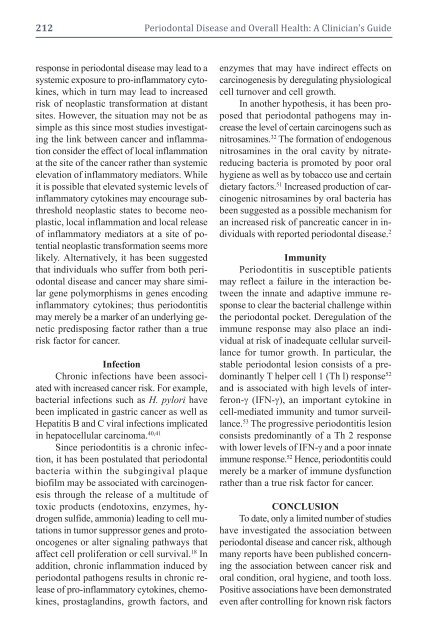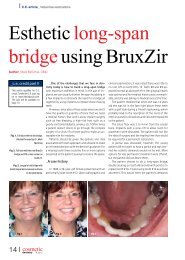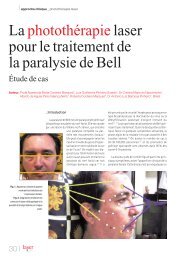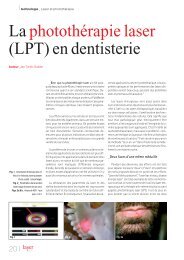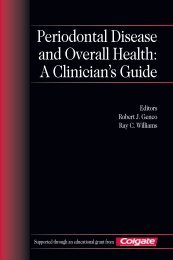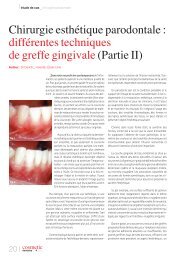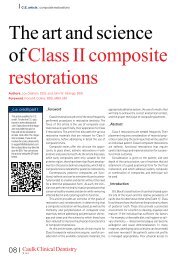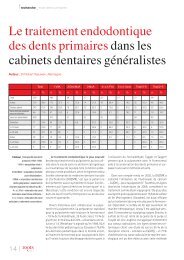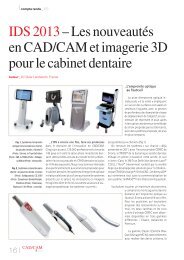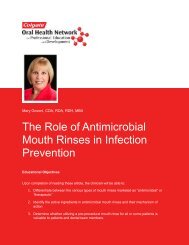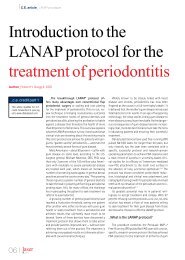212 <strong>Periodontal</strong> <strong>Disease</strong> <strong>and</strong> <strong>Overall</strong> <strong>Health</strong>: A <strong>Clinician's</strong> <strong>Guide</strong>response in periodontal disease may lead to asystemic exposure to pro-inflammatory cyto -kines, which in turn may lead to increasedrisk of neoplastic transformation at distantsites. However, the situation may not be assimple as this since most studies investigatingthe link between cancer <strong>and</strong> inflammationconsider the effect of local inflammationat the site of the cancer rather than systemicelevation of inflammatory mediators. Whileit is possible that elevated systemic levels ofinflammatory cytokines may encourage subthresholdneoplastic states to become neoplastic,local inflammation <strong>and</strong> local releaseof inflammatory mediators at a site of potentialneoplastic transformation seems morelikely. Alternatively, it has been suggestedthat individuals who suffer from both periodontaldisease <strong>and</strong> cancer may share similargene polymorphisms in genes encodinginflammatory cytokines; thus periodontitismay merely be a marker of an underlying geneticpredisposing factor rather than a truerisk factor for cancer.InfectionChronic infections have been associatedwith increased cancer risk. For example,bacterial infections such as H. pylori havebeen implicated in gastric cancer as well asHepatitis B <strong>and</strong> C viral infections implicatedin hepatocellular carcinoma. 40,41Since periodontitis is a chronic infection,it has been postulated that periodontalbacteria within the subgingival plaquebiofilm may be associated with carcinogenesisthrough the release of a multitude oftoxic products (endotoxins, enzymes, hydrogensulfide, ammonia) leading to cell mutationsin tumor suppressor genes <strong>and</strong> protooncogenesor alter signaling pathways thataffect cell proliferation or cell survival. 18 Inaddition, chronic inflammation induced byperiodontal pathogens results in chronic releaseof pro-inflammatory cytokines, chemo -kines, prostagl<strong>and</strong>ins, growth factors, <strong>and</strong>enzymes that may have indirect effects oncarcinogenesis by deregulating physiologicalcell turnover <strong>and</strong> cell growth.In another hypothesis, it has been proposedthat periodontal pathogens may increasethe level of certain carcinogens such asnitrosamines. 32 The formation of endogenousnitrosamines in the oral cavity by nitratereducingbacteria is promoted by poor oralhygiene as well as by tobacco use <strong>and</strong> certaindietary factors. 51 Increased production of carcinogenicnitrosamines by oral bacteria hasbeen suggested as a possible mechanism foran increased risk of pancreatic cancer in individualswith reported periodontal disease. 2ImmunityPeriodontitis in susceptible patientsmay reflect a failure in the interaction betweenthe innate <strong>and</strong> adaptive immune responseto clear the bacterial challenge withinthe periodontal pocket. Deregulation of theimmune response may also place an individualat risk of inadequate cellular surveillancefor tumor growth. In particular, thestable periodontal lesion consists of a predominantlyT helper cell 1 (Th l) response 52<strong>and</strong> is associated with high levels of interferon-(IFN-), an important cytokine incell-mediated immunity <strong>and</strong> tumor surveillance.53 The progressive periodontitis lesionconsists predominantly of a Th 2 responsewith lower levels of IFN- <strong>and</strong> a poor innateimmune response. 52 Hence, periodontitis couldmerely be a marker of immune dysfunctionrather than a true risk factor for cancer.CONCLUSIONTo date, only a limited number of studieshave investigated the association betweenperiodontal disease <strong>and</strong> cancer risk, althoughmany reports have been published concerningthe association between cancer risk <strong>and</strong>oral condition, oral hygiene, <strong>and</strong> tooth loss.Positive associations have been demonstratedeven after controlling for known risk factors
Chapter 13 Oral <strong>Health</strong>, Periodontitis, <strong>and</strong> Cancer 213such as smoking or when analyses are restrictedto nonsmokers. However, these findingsneed to be interpreted with caution asthere may be additional confounding factorsthat researchers are unaware of <strong>and</strong> that havenot been included in the analyses for adjustment.There is a need for more studies ofappropriate statistical power using appropriatemarkers for periodontal disease, appropriateconsideration of the different types ofperiodontal disease, as well as the appropriateconsideration of confounding factors.Supplemental ReadingsMeyer MS, Joshipura KJ, Giovannucci E, Michaud DS.A review of the relationship between tooth loss, periodontaldisease <strong>and</strong> cancer. Cancer Causes Control2008;19:895–907.Michaud DS, Joshipura K, Giovannucci E, Fuchs CS. Aprospective studyof periodontal disease <strong>and</strong> pancreaticcancer in US male health professionals. J Nat CancerInst 2007;17:171–175.Hujoel PP, Drangsholt M, Spiekerman C, Weiss NS.An exploration of the periodontitis-cancer association.Ann Epidemiol 2003;13:312–316.Michaud DS, Liu Y, Meyer M, Giovannucci E, JoshipuraK. <strong>Periodontal</strong> disease, tooth loss, <strong>and</strong> cancerrisk in male health professionals: A prospective cohortstudy. Lancet Oncol 2008;9:550–558.Coussens LM, Werb Z. Inflammation <strong>and</strong> cancer. Nature2002;420:860-867.Karin M, Greten FR. NF-Kappaβ: linking inflammation<strong>and</strong> immunity to cancer development <strong>and</strong> progression.Nat Rev Immunol 2005;5:749–759.ReFeReNCeS1. Meyer MS, Joshipura KJ, Giovannucci E, MichaudDS. A review of the relationship between toothloss, periodontal disease <strong>and</strong> cancer. Cancer CausesControl 2008;19:895–907.2. Michaud DS, Joshipura K, Giovannucci E, FuchsCS. A prospective study of periodontal disease <strong>and</strong>pancreatic cancer in US male health professionals.J Nat Cancer Inst 2007;17:171–175.3. Wynder EL, Bross IJ, Feldman RM. A study of theetiological factors in cancer of the mouth. Cancer1957;10:1300–1323.4. Graham S, Dayal H, Rohrer T, Swanson M, Sultz H,Shedd D, Fischman S. Dentition, diet, tobacco, <strong>and</strong>alcohol in the epidemiology of oral cancer. J NatlCancer Inst 1977;59:1611–1618.5. Zheng TZ, Boyle P, Hu HF, Duan J, Jian PJ, Ma DQ,Shui LP, Niu SR, Scully C, MacMahon B. Dentition,oral hygiene, <strong>and</strong> risk of oral cancer: A casecontrolstudy in Beijing, People’s Republic ofChina. Cancer Causes Control 1990;1:235–241.6. Winn DM, Blot WJ, McLaughlin JK, Austin DF,Greenberg RS, Preston-Martin S, Schoenberg JB,Fraumeni JF Jr. Mouthwash use <strong>and</strong> oral conditionsin the risk of oral <strong>and</strong> pharyngeal cancer. CancerRes 1991;51:3044–3047.7. Marshall JR, Graham S, Haughey BP, Shedd D,O’Shea R, Brasure J, Wilkinson GS, West D.Smoking, alcohol, dentition <strong>and</strong> diet in the epidemi -ology of oral cancer. Eur J Cancer. Part B. OralOncology 1992;28B:9–15.8. Bundgaard T, Wildt J, Frydenberg M, Elbrønd O,Nielsen JE. Case-control study of squamous cellcancer of the oral cavity in Denmark. CancerCauses Control 1995;6:57–67.9. Schildt EB, Eriksson M, Hardell L, Magnuson A.Oral infections <strong>and</strong> dental factors in relation to oralcancer: a Swedish case-control study. Eur J CancerPrev 1998;7:201–206.10. Velly AM, Franco EL, Schlecht N, Pintos J,Kowalski LP, Oliveira BV, Curado MP. Relationshipbetween dental factors <strong>and</strong> risk of upper aero -digestive tract cancer. Oral Oncol 1998;34:284–291.11. Talamini R, Vaccarella S, Barbone F, Tavani A, LaVecchia C, Herrero R, Muñoz N, Franceschi S.Oral hygiene, dentition, sexual habits <strong>and</strong> risk oforal cancer. Br J Cancer 2000;83:1238–1242.12. Moreno-López LA, Esparza-Gómez GC, González-Navarro A, Cerero-Lapiedra R, González-HernándezMJ, Domínguez-Rojas V. Risk of oral cancer associatedwith tobacco smoking, alcoholconsumption <strong>and</strong> oral hygiene: a case-control studyin Madrid, Spain. Oral Oncol 2000;36:170–174.13. Garrote LF, Herrero R, Reyes RM, Vaccarella S,Anta JL, Ferbeye L, Muñoz, N, Franceschi S. Riskfactors for cancer of the oral cavity <strong>and</strong> oro-pharynxin Cuba. Br J Cancer 2001;85:46–54.14. Balaram P, Sridhar H, Rajkumar T, Vaccarella S,Herrero R, N<strong>and</strong>akumar A, Ravich<strong>and</strong>ran K, RamdasK, Sankaranarayanan R, Gajalakshmi V, MuñozN, Franceschi S. Oral cancer in southern India: theinfluence of smoking, drinking, paan-chewing <strong>and</strong>oral hygiene. Int J Cancer 2002;98:440–445.15. Lissowska J, Pilarska A, Pilarski P, Samolczyk-Wanyura D, Piekarczyk J, Bardin-Mikollajczak A,Zatonski W, Herrero R, Muñoz N, Franceschi S.Smoking, alcohol, diet, dentition <strong>and</strong> sexual practicesin the epidemiology of oral cancer in Pol<strong>and</strong>.Eur J Cancer Prev 2003;12:25–33.


